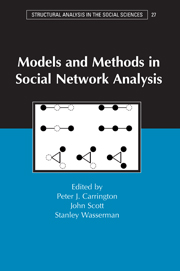Book contents
- Frontmatter
- Contents
- Acknowledgments
- Contributors
- 1 Introduction
- 2 Recent Developments in Network Measurement
- 3 Network Sampling and Model Fitting
- 4 Extending Centrality
- 5 Positional Analyses of Sociometric Data
- 6 Network Models and Methods for Studying the Diffusion of Innovations
- 7 Using Correspondence Analysis for Joint Displays of Affiliation Networks
- 8 An Introduction to Random Graphs, Dependence Graphs, and p*
- 9 Random Graph Models for Social Networks: Multiple Relations or Multiple Raters
- 10 Interdependencies and Social Processes: Dependence Graphs and Generalized Dependence Structures
- 11 Models for Longitudinal Network Data
- 12 Graphic Techniques for Exploring Social Network Data
- 13 Software for Social Network Analysis
- Index
- Structural Analysis in the Social Sciences
6 - Network Models and Methods for Studying the Diffusion of Innovations
Published online by Cambridge University Press: 05 June 2012
- Frontmatter
- Contents
- Acknowledgments
- Contributors
- 1 Introduction
- 2 Recent Developments in Network Measurement
- 3 Network Sampling and Model Fitting
- 4 Extending Centrality
- 5 Positional Analyses of Sociometric Data
- 6 Network Models and Methods for Studying the Diffusion of Innovations
- 7 Using Correspondence Analysis for Joint Displays of Affiliation Networks
- 8 An Introduction to Random Graphs, Dependence Graphs, and p*
- 9 Random Graph Models for Social Networks: Multiple Relations or Multiple Raters
- 10 Interdependencies and Social Processes: Dependence Graphs and Generalized Dependence Structures
- 11 Models for Longitudinal Network Data
- 12 Graphic Techniques for Exploring Social Network Data
- 13 Software for Social Network Analysis
- Index
- Structural Analysis in the Social Sciences
Summary
Introduction
Diffusion of innovations theory attempts to explain how new ideas and practices spread within and between communities. The theory has its roots in anthropology, economics, geography, sociology, and marketing, among other disciplines (Hägerstrand 1967; Robertson 1971; Brown 1981; Rogers 2003), and has in some ways been adapted from epidemiology (e.g., Bailey 1975; Morris 1993). The premise, confirmed by empirical research, is that new ideas and practices spread through interpersonal contacts largely consisting of interpersonal communication (Ryan and Gross 1943; Beal and Bohlen 1955; Katz, Levine, and Hamilton 1963; Rogers 1995; Valente 1995; Valente and Rogers 1995).
In their pioneering study, Ryan and Gross (1943) laid the groundwork for the diffusion paradigm by showing that, among other things, social factors rather than economic ones were important influences on adoption (Valente and Rogers 1995). Hundreds of diffusion studies were conducted in the 1950s and early 1960s to examine the diffusion process in more detail across a variety of settings (Rogers 2003). Many studies sought to understand how information created in government or otherwise sponsored programs could be disseminated more effectively. Diffusion research peaked in the early 1960s, but has been reinvigorated more recently with the advent of more sophisticated network models and technology making it possible to study the diffusion process more explicitly.
Most diffusion studies focus on trying to understand the factors that lead some members of a population to adopt a new idea and others do not.
- Type
- Chapter
- Information
- Models and Methods in Social Network Analysis , pp. 98 - 116Publisher: Cambridge University PressPrint publication year: 2005
- 153
- Cited by



